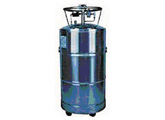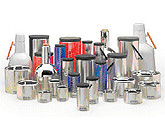Handling Cryogenic Liquids
See requirements for UC San Diego researchers working with cryogenic liquids.
Cryogenic liquids are liquefied gases with temperatures below -73°C (-100° F). Cryogenic liquids commonly used at UC San Diego include:
- Liquid air
- Liquid argon
- Liquid helium
- Liquid nitrogen
- Liquid oxygen
- Slush mixtures of dry ice with isopropanol
Requirement for researchers
UC San Diego researchers working with liquefied gases must complete the "Compressed Gas" and "Cryogenic Liquids" hazard control plan (HCP) obtained through the HCP application. This HCP must be preapproved by the principal investigator prior to beginning any work with this material. Information on this Blink page is supplementary and is not intended to replace the approved HCP.
Obtain approval before beginning work.
Evaluate the hazards before beginning work.
- Consult safety resources:
- Safety Data Sheet (SDS) Sources
- 6.E.2 Liquefied Gases and Cryogenic Liquids, "Prudent Practices in the Laboratory: Handling and Disposal of Chemicals" (1995), The National Academies Press
- Cryogenic Liquid Containers (PDF), Air Products Safetygram-27
- Consider these hazards specific to cryogenic liquids:
- Health hazards:
- Never permit unprotected body parts to directly contact cryogenic liquids or uninsulated vessels containing cryogenic liquids.
- Contact with cryogenic liquids results in painful burns.
- Boil-off vapors rapidly freeze human tissue.
- Use caution when sealing containers that have been highly cooled. Cryogenic liquids with temperatures below -73°C condense room air gases. Condensed room air gases will expand and may explode when allowed to warm.
- Gases produced can damage the eyes and cause vision loss.
- Risk of asphyxiation: Cryogenic liquids produce large volumes of gas upon vaporization, displacing normal air — a 1-liter spill releases 1 cubic meter of gas. This may create oxygen-deficient conditions (asphyxiation).
- Because nitrogen makes up 79% of our breathable air, we cannot detect an increasing concentration of nitrogen and reduced concentration of oxygen, resulting in a very dangerous situation.
- Breathing an atmosphere that contains less than 18% oxygen can cause dizziness and quickly result in unconsciousness and death.
- Very small rooms or rooms with poor air-handling systems are particularly hazardous and should never house large storage dewars.
- Never permit unprotected body parts to directly contact cryogenic liquids or uninsulated vessels containing cryogenic liquids.
- Operational hazards:
- Boil-off vapors can rapidly cause embrittlement of many common materials and cause them to shatter.
- Excessive ice buildup can result in the discharge of cold gas or structural damage to the cryogenic container or its surroundings.
- Fire and explosion hazards:
- Fire or explosion from oxygen condensation in operational equipment such as cold traps or storage dewars is a serious concern.
- Liquid oxygen (boiling point 183°C, 90K) is a pale blue color and will condense in a bucket of liquid nitrogen or form on a liquid nitrogen-cooled surface. It may collect into a dangerous quantity and lead to an explosion or fire.
- Oil or grease may ignite spontaneously and violently in the presence of high oxygen concentrations.
- Many materials not usually combustible in air burn fiercely in an oxygen-enriched atmosphere. Remove all sources of ignition in areas where oxygen enrichment is likely to occur.
- Health hazards:
- If possible, use a less dangerous product that can perform the same task.
- Consult the EH&S Chemical Hygiene Officer, on training procedures for any new or revised projects that will use large quantities of cryogenic liquids.

Large nitrogen dewar
Follow these training guidelines.
The PI or a knowledgeable designee must provide appropriate safety training.
- Inform employees about handling cryogenic liquids, their specific hazards, and health effects.
- Explain possible routes of exposure, as appropriate:
- Skin contact
- Eye exposure
- Inhalation
- Provide personal protective equipment and engineering controls, and train employees in their proper use.
- Consult the EH&S Chemical Hygiene Officer on training procedures for any new or revised projects that will:
- Use large quantities of cryogenic liquids
- Heat cryogenic liquids
- Keep training records on file, including:
- Information covered
- Date
- Names
- Employee signatures
Be prepared for accidental spills.
- Read How to Handle Chemical Spills in Laboratories.
- Print and keep the Safety Data Sheet (formerly called Material Safety Data Sheet) for the cryogenic liquids used with your emergency supplies.
- Know the location of safety equipment, including eye wash, shower station, first aid kit, and Emergency Guide.
- Know the contact information for your vendor in case of storage dewar failure.
Follow these purchasing and storage guidelines.
- Buy the least amount of cryogenic liquid the work requires.
- Label all containers with this information:
- Name of the material
- Warnings
- Date, when appropriate
- Use seismic restraints to secure large dewars. Large nitrogen dewars must be restrained to the wall with a
top-ring teather . - Label the work area with a sign saying "Cryogenic Liquid Use Area."
- Follow these storage guidelines:
- Keep containers clean and dry.
- Moisture, animal waste, chemicals, strong cleaning agents, and other substances can promote corrosion or clog relief valves.
- Use water or
mild detergent for cleaning and dry the surface thoroughly. - Do not use strong alkaline or acid cleaners that could damage the finish and corrode the metal shell.
- Store and use cryogenic liquids only in well-ventilated locations.
- Pressurized cylinders of liquefied cryogenic gases (e.g., insulated vacuum-jacketed, pressure vessels equipped with pressure relief valves and rupture disks — any cylinder that operates at pressures of up to 350 PSIG with capacities between 80 - 450 liters of liquid) secured to the wall with a top ring tether
- Contact the EH&S Chemical Hygiene Officer if you have questions about chemical and container compatibility.
- Keep containers clean and dry.
Control the hazards.
Handle cryogenic liquids with extreme care.
- Engineering controls:
- Make sure rooms where cryogens are used have good air handling capacity.
- General laboratory room ventilation is usually adequate.
- Unventilated closets and/or small rooms with poor ventilation can be a serious asphyxiation risk.
- Evaluate your space to see if the rapid loss of containment would depress oxygen to below 19.5%. If yes, you must install an O2 monitor.
- Contact the EH&S Chemical Hygiene Officer for details or an evaluation.
- All cryogenic systems, including piping, must be fitted with pressure relief devices that are directed to a safe location.
- Make sure rooms where cryogens are used have good air handling capacity.
- Operational controls:
- Be alert for the condensation of oxygen from the air.
- Never use hollow rods or tubes as dipsticks.
- When a warm tube is inserted into liquid nitrogen, liquid spouts from the bottom of the tube due to gasification and rapid expansion of liquid inside the tube.
- Wooden or solid metal dipsticks are recommended.
- Avoid using plastics that may become very brittle at cryogenic temperatures.
- Use hot air, steam, or water to thaw frozen equipment. Caution: Do not use water to thaw liquid helium equipment.
- Never dispose of cryogenic liquids in confined areas or places where others may enter. Dispose of liquid nitrogen outdoors in a safe place.
- Pour the liquid slowly on gravel or bare earth where it can evaporate without causing damage.
- Do not pour the liquid on the pavement.
- Transferring cryogenic liquids between containers:
- Fill containers SLOWLY to minimize the internal stresses that occur when any material is cooled.
- Do not overfill containers. Fill only to the bottom of the necktube.
- Minimize boiling and splashing of cryogenic liquid when transferring to an open container such as a dewar.
- Use a phase separator or special filling funnel to prevent splashing and spilling when transferring cryogenic liquids into or from a dewar or refrigerator.
- Partly cover the top of the funnel to reduce splashing.
- Use only small, easily handled dewars for pouring liquid.
- For the larger, heavier containers, use a cryogenic liquid withdrawal device to transfer liquid from one container to another.
- When liquid cylinders or other large storage containers are used for filling, follow the instructions supplied with those units and their accessories.
- Containers:
- Use high-quality dewars with protective covers instead of standard thermos bottles.
- Do not cover or plug container openings. Cryogenic liquid containers are generally designed to operate with little or no internal pressure. Inadequate venting can result in excessive pressure, possibly damaging or bursting the container.
- Use only the loose-fitting necktube core supplied by the manufacturer, or one of the approved accessories for closing the necktube.
- Check containers periodically to be sure that venting is not restricted.
- Be vigilant against ice plug formation. Because oxygen has a higher boiling point than hydrogen, helium, or nitrogen, it can be condensed out of the atmosphere with the use of those lower boiling point cryogens. Use with liquid hydrogen is particularly dangerous!
- Keep containers upright at all times, except when pouring liquid from dewars specifically designed for that purpose.
- Use a dolly or handcart when moving containers. Do not "walk," roll, or drag these units across a floor. Rough handling can cause serious damage to dewars and refrigerators.
- Wear this personal protective equipment:
- Lab coat with sleeves fully extended to the wrists
- Safety glasses or splash goggles and face shield — always wear a face shield during transfer of cryogenic liquids
- Loose insulated gloves
- Full-length pants
- Rubber apron
- Closed-toe shoes
- Follow these PPE guidelines:
- Avoid clothing that can trap spilled liquid.
- Leave all personal protective equipment in the lab when your work is complete.

Insulated vessels for transporting and manipulating cryogenic liquids
Act quickly if an exposure occurs.
Give first aid treatment, then seek medical attention immediately for any and all cryogenic liquid exposures. Treat any exposure seriously, no matter how slight it may seem at the moment.
- Skin exposure: Do not rub the skin. Instead, place the affected body part in a warm water bath (<105°F).
- Eye exposure: Flush eyes with water for at least 15 minutes. Affected individuals may need help holding their eyes open under water.
- Ingestion: Seek medical attention immediately.
- For all exposures:
- Seek medical attention immediately at an emergency room.
- Call Campus Police at (858) 534-4357 (534-HELP) and request an ambulance if transportation is necessary.
- Call the California Poison Control System, (800) 222-1222, if additional information is needed.
Dispose of waste properly.
- Read about how to:
- Identify hazardous chemical waste
- Store and dispose of hazardous and extremely hazardous chemical waste
- Request a hazardous waste collection